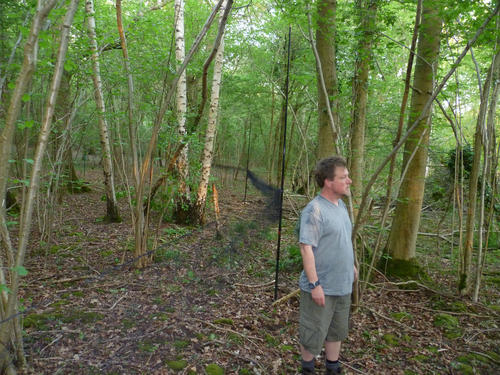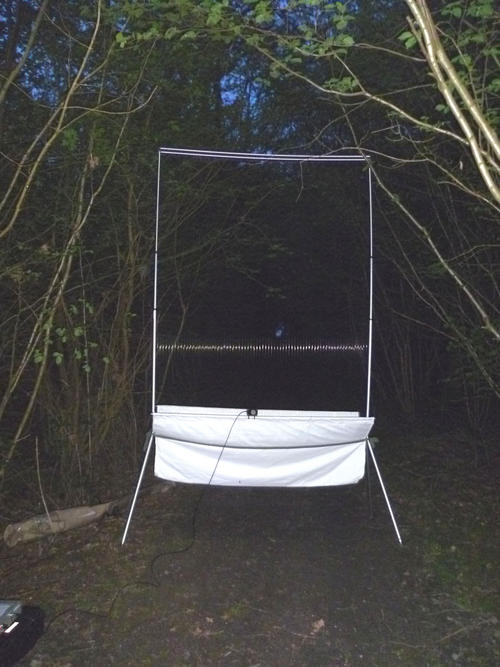Bechstein's Bat - a study on the population size, foraging range and roosting ecology at Grafton Wood, Worcestershire, 2012. A preliminary summary of findings
Johnny Birks, Eric Palmer and James Hitchcock
This article follows on from The National Bechstein’s Survey and Beyond in Worcestershire Record (Sedgeley et al 2012), which outlined the efforts to identify the presence of Bechstein’s bat in Worcestershire, and the subsequent successful bid for funding from the Peoples’ Trust for Endangered Species (PTES) for further studies. The funding enabled us to carry out a radio tracking project aimed at increasing our knowledge of the roosting and foraging habitats of Bechstein’s Bat in a managed woodland. Worcestershire Wildlife Trust initiated the work, in partnership with Johnny Birks and Eric Palmer, following the record of a lactating female Bechstein’s Bat at Grafton Wood which indicated there was probably a colony of the bats living in, or around, the wood. Since Grafton Wood became a nature reserve in 1997, its management has been driven mainly with invertebrates in mind and their need for open space and high light levels. This management has been very successful in encouraging diversity and increasing butterfly numbers and breeding birds. However, past studies have shown (Schofield & Morris, 2000) that Bechstein’s bats favour foraging under closed canopy woodland with a strong understorey (Harris & Yalden 2008) which is well represented in Grafton Wood (Fig. 1.), alongside the actively managed rides and coppice plots. So, it was felt a detailed study to aid understanding of how the bats use the wood was much needed and would provide information for the management plan and ensure that bats were considered alongside other species in the future.
The project depended largely upon a very successful collaboration with the Worcestershire Bat Group whose members committed a huge amount of time and energy helping with catching (using harp traps and mist nets) and radio-tracking Bechstein’s bats at Grafton Wood through the rain-soaked summer ot 2012. We are indebted to them for their massive contribution and their remarkable ability to stay cheerful through the wettest and muddiest summer in 100 years.
Well, what did the project find out? At the time of writing the detailed analysis of data is still taking place, but, we can share some preliminary findings.
Despite the best disruptive attempts of the awful weather, tagging and radio-tracking was carried out, as planned, across three main survey periods: May, June and end August/beginning of September - chosen to avoid catching bats when they would be heavily pregnant or feeding young.
Our early season catch was almost entirely of underweight bats of all species, with additional problems due to a higher than average tag failure rate and of course the weather. Despite this we were able to fit one tag in May and start the process of chasing bats around in the dark. By the end of the season we had fitted a total of eight tags, four less than was hoped and had identified eleven day-roost trees – five in Grafton Wood and six outside. Tree species used were Willow(3), Oak(4), Ash(3) and Silver Birch(1). None of the roosts were in old woodpecker holes, one in a natural rot hole and the other (a lone male bat) in a crack. Through the identification of roosts we were able to carry out timed roost emergence counts which gave us a maximum count of 50 bats which emerged from a woodpecker hole in a Crack Willow pollard.
Of the roosts outside the wood the furthest away was just over 1.5km south. This kind of distance has been recorded in other studies, but was still something of a surprise to us, especially given that the area to the south of the wood happens to be the least wooded area around Grafton Wood.
Overall, we found a bias in bat activity towards the south of the wood, both in terms of roosting and foraging within the wood and the roosts outside of it. Roosts were often near water – the Piddle Brook or a farm pond – which could be a coincidence or it could highlight a need for flight corridors.
Tracking foraging bats revealed that they favour discrete areas of closed-canopy woodland with a strong understorey, which confirmed much of what we had read about the bats in previous studies. However, our late-season animals also foraged around field edges, plantation woodland and along watercourses.
The radio-tags allowed us to confirm that the colony frequently switched roosts, often en masse, which may have been a result of the inclement weather, but may highlight other needs: the bats may move regularly to prevent the build up of waste and parasites, which may increase the risk of disease. Frequent roost switching does bring home the importance of the availability of a wide variety of potential roost trees, in a variety of settings, with woodpecker holes (and other cavities) in them.
The final report will aim to characterise the roost trees, define and characterise foraging areas and perhaps shed some light on what features of the landscape around the Wood really are the most important habitat for commuting and foraging Bechstein’s Bats.
One thing that we can say at this stage is that despite the challenges presented by the weather and the demands of night-time radio-tracking faced so bravely by our band of volunteers, we have hugely increased our knowledge and understanding of Bechstein’s Bat in Grafton Wood and its environs. And it appears that we have a healthy sized breeding colony. As with all scientific field studies we have only just begun to scratch the surface and there is still much more to learn and more work to be done. We hope to follow up this study with the introduction of 100 roosting boxes – woodcrete Schwegler 2FNs - into Grafton Wood which, if used, will allow us to monitor the colony size and, if we can organise ringing the bats, we will hopefully be able to gather data on other important population parameters.
These are exciting times! A full update will follow after the report is published
Notes
Grafton Wood Nature Reserve is jointly owned and managed by Worcestershire Wildlife Trust and Butterfly Conservation.
Harp traps (Fig. 2.) have vertical nylon strings – fishing line type stuff – that is strung vertically in two slightly offset rows. They are sited in areas where bats are likely to be foraging and are used in conjunction with an acoustic lure, which plays bat social calls. The lure elicits a territorial response in the bats and they fly toward the sound and then into the trap. The strings are set so they “absorb” the bat, causing its wings to fold, the bat then falls down into a pouch which has a two layers of plastic, one clear and one cream, which are set up so the bat can fall in but not fly or crawl out. The bat crawls into the space between the plastic as it is rather like being in a roost for them. The bats are then easily extracted by hand – much easier than mist nets so can be done by less experienced people.
Worcestershire Wildlife Trust gratefully acknowledges the financial support given to the project by the Peoples’ Trust for Endangered Species (PTES).
References
Harris, S.& Yelden, D.W. 2008 Mammals of the British Isles: Handbook. 4th Edition. Southampton: The Mammal Society.
Schofield, H. & Morris, C. 2000. Ranging behaviour and habitat preferences of female Bechstein’s bat, Myotis bechsteinii (Kuhl, 1818), in summer. Report held by The Vincent Wildlife Trust.
Sedgeley, J., Hitchcock, J. & Birks, J. 2012. The National Bechstein’s Bat survey and beyond. Worcestershire Record. 32:24-25.
Images
1. Excellent habitat for Bechstein's Bat with mistnet.
2. Harp trap set in Grafton Wood.

